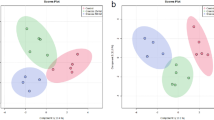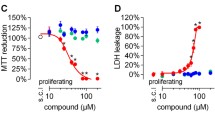Abstract
As part of a study on cadmium nephrotoxicity, we studied the effect of cadmium chloride (CdCl2) in isolated human renal proximal tubules metabolizing the physiological substrate lactate. Dose–effect experiments showed that 10–500 μM CdCl2 reduced lactate removal, glucose production and the cellular levels of ATP, coenzyme A, acetyl-coenzyme A and of reduced glutathione in a dose-dependent manner. After incubation with 5 mM l-[1-13C]-, or l-[2-13C]-, or l-[3-13C] lactate or 5 mM l-lactate plus 25 mM NaH13CO3 as substrates, substrate utilization and product formation were measured by both enzymatic and carbon 13 NMR methods. Combination of enzymatic and NMR measurements with a mathematical model of lactate metabolism previously validated showed that 100 μM CdCl2 caused an inhibition of flux through lactate dehydrogenase and alanine aminotransferase and through the entire gluconeogenic pathway; fluxes were diminished by 19% (lactate dehydrogenase), 28% (alanine aminotransferase), 28% (pyruvate carboxylase), 42% (phosphoenolpyruvate carboxykinase), and 52% (glucose-6-phosphatase). Such effects occurred without altering the oxidation of the lactate carbons or fluxes through enzymes of the tricarboxylic acid cycle despite a large fall of the cellular ATP level, a marker of the energy status and of the viability of the renal cells. These results that were observed at clinically relevant tissue concentrations of cadmium provide a biochemical basis for a better understanding of the cellular mechanism of cadmium-induced renal proximal tubulopathy in humans chronically exposed to cadmium.



Similar content being viewed by others
References
ATSDR (2008) Draft toxicological profile for cadmium. from http://www.atsdr.cdc.gov/toxprofiles/tp5.html
Baverel G, Bonnard M, Pellet M (1979) Lactate and pyruvate metabolism in isolated human kidney tubules. FEBS Lett 101(2):282–286
Bernhard D, Rossmann A, Henderson B et al (2006) Increased serum cadmium and strontium levels in young smokers: effects on arterial endothelial cell gene transcription. Arterioscler Thromb Vasc Biol 26(4):833–838
Beyersmann D, Hechtenberg S (1997) Cadmium, gene regulation, and cellular signalling in mammalian cells. Toxicol Appl Pharmacol 144(2):247–261
Bridges CC, Zalups RK (2005) Molecular and ionic mimicry and the transport of toxic metals. Toxicol Appl Pharmacol 204(3):274–308
Burch HB, Narins RG, Chu C et al (1978) Distribution along the rat nephron of three enzymes of gluconeogenesis in acidosis and starvation. Am J Physiol 235(3):F246–F253
Canioni P, Alger JR, Shulman RG (1983) Natural abundance Carbon-13 nuclear magnetic resonance spectroscopy of liver and adipose tissue of the living rat. Biochemistry 22(21):4974–4980
Cersosimo E, Garlick P, Ferretti J (2000) Renal substrate metabolism and gluconeogenesis during hypoglycemia in humans. Diabetes 49(7):1186–1193
Chapatwala KD, Rajanna B, Desaiah D (1980) Cadmium induced changes in gluconeogenic enzymes in rat kidney and liver. Drug Chem Toxicol 3(4):407–420
Chauvin MF, Megnin-Chanet F, Martin G et al (1994) The rabbit kidney tubule utilizes glucose for glutamine synthesis. A 13C NMR study. J Biol Chem 269(42):26025–26033
Dorta DJ, Leite S, DeMarco KC et al (2003) A proposed sequence of events for cadmium-induced mitochondrial impairment. J Inorg Biochem 97(3):251–257
Dudley RE, Gammal LM, Klaassen CD (1985) Cadmium-induced hepatic and renal injury in chronically exposed rats: likely role of hepatic cadmium-metallothionein in nephrotoxicity. Toxicol Appl Pharmacol 77(3):414–426
Dugelay S, Chauvin MF, Megnin-Chanet F et al (1999) Acetate stimulates flux through the tricarboxylic acid cycle in rabbit renal proximal tubules synthesizing glutamine from alanine: a 13C NMR study. Biochem J 342(Pt 3):555–566
Ellis KJ, Morgan WD, Zanzi I et al (1980) In vivo measurement of critical level of kidney cadmium: dose effect studies in cadmium smelter workers. Am J Ind Med 1(3–4):339–348
Felley-Bosco E, Diezi J (1989) Fate of cadmium in rat renal tubules: a micropuncture study. Toxicol Appl Pharmacol 98(2):243–251
Fels LM (1999) Risk assessment of nephrotoxicity of cadmium. Ren Fail 21(3–4):275–281
Friis L, Petersson L, Edling C (1998) Reduced cadmium levels in human kidney cortex in Sweden. Environ Health Perspect 106(4):175–178
Griffith OW (1980) Determination of glutathione and glutathione disulfide using glutathione reductase and 2-vinylpyridine. Anal Biochem 106(1):207–212
Hellstrom L, Persson B, Brudin L et al (2007) Cadmium exposure pathways in a population living near a battery plant. Sci Total Environ 373(2–3):447–455
Hickey EJ, Raje RR, Reid VE et al (2001) Diclofenac induced in vivo nephrotoxicity may involve oxidative stress-mediated massive genomic DNA fragmentation and apoptotic cell death. Free Radic Biol Med 31(2):139–152
Howarth OW, Lilley DMJ (1978) Carbon-13-NMR of peptides and proteins. Prog Nucl Magn Reson Spectrosc 12(1):1–40
Johri N, Jacquillet G, Unwin R (2010) Heavy metal poisoning: the effects of cadmium on the kidney. Biometals 23(5):783–792
Karmakar R, Roy S, Chatterjee M (1999) The effects of cadmium on the hepatic and renal levels of reduced glutathione, the activity of glutathione S-transferase and gamma glutamyl transpeptidase. J Environ Pathol Toxicol Oncol 18(1):29–35
Kimura O, Endo T, Sakata M (1996) Comparison of cadmium uptakes from apical and basolateral membranes of LLC-PK1 cells. Toxicol Appl Pharmacol 137(2):301–306
Kjellstrom T, Elinder CG, Friberg L (1984) Conceptual problems in establishing the critical concentration of cadmium in human kidney cortex. Environ Res 33(2):284–295
Klaassen CD, Liu J (1997) Role of metallothionein in cadmium-induced hepatotoxicity and nephrotoxicity. Drug Metab Rev 29(1–2):79–102
Lee WK, Bork U, Gholamrezaei F et al (2005) Cd(2+)-induced cytochrome c release in apoptotic proximal tubule cells: role of mitochondrial permeability transition pore and Ca(2+) uniporter. Am J Physiol Renal Physiol 288(1):F27–F39
Michal G, Bergmeyer HU (1985) Coenzyme A: catalytic method with phosphate acetyltransferase. In: Bergmeyer HU (ed) Methods of enzymatic analysis, vol VII. Verlag Chemie, Weinheim, pp 169–177
Nieth H, Schollmeyer P (1966) Substrate-utilization of the human kidney. Nature 209(5029):1244–1245
Nordberg GF (2004) Cadmium and health in the 21st century–historical remarks and trends for the future. Biometals 17(5):485–489
Passonneau JV, Lowry OH (1993) Enzymatic analysis: a practical guide. The Humana Press Inc, Totowa
Prozialeck WC (2009) New Insights into the mechanisms of cadmium toxicology–advances in cadmium research. Toxicol Appl Pharmacol 238(3):191–326
Rajanna B, Hobson M, Reese J et al (1984) Chronic hepatic and renal toxicity by cadmium in rats. Drug Chem Toxicol 7(3):229–241
Ray SD, Wong V, Rinkovsky A et al (2000) Unique organoprotective properties of a novel IH636 grape seed proanthocyanidin extract on cadmium chloride-induced nephrotoxicity, dimethylnitrosamine (DMN)-induced splenotoxicity and mocap-induced neurotoxicity in mice. Res Commun Mol Pathol Pharmacol 107(1–2):105–128
Renault S, Faiz H, Gadet R et al (2010) Uranyl nitrate inhibits lactate gluconeogenesis in isolated human and mouse renal proximal tubules: a 13C-NMR study. Toxicol Appl Pharmacol 242(1):9–17
Robinson MK, Barfuss DW, Zalups RK (1993) Cadmium transport and toxicity in isolated perfused segments of the renal proximal tubule. Toxicol Appl Pharmacol 121(1):103–111
Rutman JZ, Meltzer LE, Kitchell JR et al (1965) Effect of metal ions on in vitro gluconeogenesis in rat kidney cortex slices. Am J Physiol 208:842–846
Satarug S, Baker JR, Urbenjapol S et al (2003) A global perspective on cadmium pollution and toxicity in non-occupationally exposed population. Toxicol Lett 137(1–2):65–83
Schoolwerth AC, Smith BC, Culpepper RM (1988) Renal gluconeogenesis. Miner Electrolyte Metab 14(6):347–361
Seiller W, Echsel H, Hohenegger M (1979) On the effect of cadmium on tissue respiration and gluconeogenesis in rat kidney cortex (author’s transl). Arch Toxicol 42(3):217–222
Shaka AJ, Keeler J, Frenkiel T et al (1983) An improved sequence for broadband decoupling: WALTZ-16. J Magn Reson 52:335–338
Singhal RL, Merali Z, Kacew S et al (1974) Persistence of cadmium-induced metabolic changes in liver and kidney. Science 183(129):1094–1096
Stohs SJ, Bagchi D (1995) Oxidative mechanisms in the toxicity of metal ions. Free Radic Biol Med 18(2):321–336
Thevenod F (2003) Nephrotoxicity and the proximal tubule. Insights from cadmium. Nephron Physiol 93(4):p87–p93
Vittorelli A, Gauthier C, Michoudet C et al (2005) Characteristics of glutamine metabolism in human precision-cut kidney slices: a 13C-NMR study. Biochem J 387(Pt 3):825–834
Winkel C, Jans AW (1990) A 13C-NMR study on metabolic changes in proximal convoluted tubule cells induced by cadmium. Toxicol Lett 53(1–2):173–174
Wolff NA, Abouhamed M, Verroust PJ et al (2006) Megalin-dependent internalization of cadmium-metallothionein and cytotoxicity in cultured renal proximal tubule cells. J Pharmacol Exp Ther 318(2):782–791
Zalups RK (2000) Evidence for basolateral uptake of cadmium in the kidneys of rats. Toxicol Appl Pharmacol 164(1):15–23
Zalups RK, Ahmad S (2003) Molecular handling of cadmium in transporting epithelia. Toxicol Appl Pharmacol 186(3):163–188
Acknowledgments
This work was financially supported by the CEA, INSERM, INRA and CNRS by the “ToxNuc-E” program. The authors thank J.L. Imbert and D. Gonnet (service central d’analyse du CNRS à Solaize) for the determination of cadmium content in the proximal tubules.
Conflict of interest
The authors have no conflict of interest.
Author information
Authors and Affiliations
Corresponding author
Rights and permissions
About this article
Cite this article
Faiz, H., Conjard-Duplany, A., Boghossian, M. et al. Cadmium chloride inhibits lactate gluconeogenesis in isolated human renal proximal tubules: a cellular metabolomic approach with 13C-NMR. Arch Toxicol 85, 1067–1077 (2011). https://doi.org/10.1007/s00204-010-0633-6
Received:
Accepted:
Published:
Issue Date:
DOI: https://doi.org/10.1007/s00204-010-0633-6




